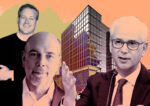Trending
Foreign exchange

In recent months, New York City has surged ahead of its biggest global rivals, London and Tokyo, with more dollar volume in real estate investment than any other city in the world.
It’s not surprising that much of the capital rushing into New York is coming from foreign investors and often from sovereign wealth funds: state-controlled investment bodies responsible for allocating countries’ cash reserves. Gary Barnett’s new Manhattan condo One57, for example, is backed by investors from Abu Dhabi, and the Chinese investment firm SOHO China recently bought a $1.4 billion stake in the General Motors Building. In total, foreign investors poured $1.96 billion into Manhattan real estate in the first half of 2013, according to data firm Real Capital Analytics.
And it may soon get even easier for foreign investors to buy a piece of the Big Apple: the proposed Real Estate Investment and Jobs Act of 2013, which is currently being pushed by several members of Congress including Queens’ Congressman Joseph Crowley, would allow a more lenient tax policy for foreign entities investing in the U.S.
But while foreign entities have been investing in New York City real estate for years, they’ve changed their strategy significantly since the economic crisis. Industry experts say there’s been a serious shift in the major sources of international capital, as well as a change in investors’ strategies for parking money in New York City.
For instance, players from Asia — both private individuals and institutional funds — have increased their investment in Manhattan property, from under $200 million in 2010 to $1.36 billion in 2012, according to RCA’s data. During that same period, investors from Australia and certain areas of Europe, particularly Germany, loosened their grip on the Manhattan market.
International investors have also recently started making more direct investments in Manhattan real estate — purchasing a stake in a building, or providing equity or debt financing to a local developer, rather than investing in a real estate investment trust or a large fund like the Blackstone Group.
While direct investments have some drawbacks, they allow foreign companies to make more decisions about which assets to buy and sell.
“We just came out of a period where people saw that not every investment paid off well,” said Howard Michaels, CEO of the Manhattan real estate banking firm the Carlton Group. Now “we’re seeing more direct investment because the investors want to have more control over their decisions, as opposed to bring part of a fund.”
Ramping up activity
It’s well-known that the Chinese economy has grown aggressively in recent years, fueled by globalization and the country’s vast and cheap labor force. In 2010, China became the world’s second largest economy after the United States.
But recently, a number of factors have prompted Chinese investors to invest abroad. Perhaps most notably, the Chinese government in 2011 famously instituted a “one apartment policy,” making it difficult for homebuyers to purchase more than one property in any major city in the country. While the policy has helped curb a pricing bubble in the country, it’s made it less attractive for Chinese developers to build residential projects at home.
New condos in China “used to fly off the shelf,” said James Nelson of Massey Knakal Realty Services, but the new policy “has certainly cooled that market.”
As a result, “there’s a tremendous amount of wealth that’s trying to make it to the U.S,” said Nelson, who recently completed a six-city tour of China.
Chief among these wealthy investors is business magnate Zhang Xin, the CEO of development company SOHO China, who has spent more money on Manhattan real estate than any international investor in the last three years, according to data from RCA.
In 2011, Xin reportedly paid $600 million for a 49 percent stake in Park Avenue Plaza, an office tower at 55 East 52nd Street. And in June of this year, Xin’s family partnered with Brazilian banking mogul Moise Safra to buy a 40 percent stake in America’s most valuable office tower, the General Motors Building, for $700 million. (The partnership also assumed a large amount of the debt attached to the $3.4 billion property.)
Other Chinese investors bullish on New York include HNA Group, a Chinese airline company, which bought the Manhattan office building 1180 Sixth Avenue for $265 million in 2011. HNA has also been active outside of New York City, acquiring close to $5 billion worth of real estate globally in the last three years, according to RCA.
Even the Chinese government is getting in on the action through the sovereign wealth fund China Investment Corp. In 2011, CIC partnered with AREA Real Estate Finance to buy a preferred equity stake in the Midtown office tower 650 Madison Avenue for an undisclosed sum. (Crown Acquisitions is currently in contract to buy that building for $1.3 billion.)
Asian investors are by no means limited to those from China. The National Pension Service of South Korea, which owns stakes in 230 Park Avenue and 300 Park Avenue, has spent nearly $950 million on Manhattan real estate over the last three years, according to RCA’s findings.
Other groups of investors who are active in New York City real estate include those from Canada, Norway and the Middle East. Caisse de Depot, a manager of public pension funds in Quebec, has spent more than $1.25 billion in direct investments in Manhattan real estate over the last three years, primarily through its real estate subsidiary Ivanhoé Cambridge, according to RCA. In November 2012, Ivanhoé partnered with the California-based Swig Company to buy the Times Square office tower 1411 Broadway. Ivanhoé has also reportedly inked a deal to buy a stake in another Midtown office building, 1211 Sixth Avenue.
The small Middle Eastern country of Kuwait has also been notably active. Indeed, its sovereign wealth fund, the Kuwait Investment Authority, has spent almost $500 million on Manhattan real estate over the past three years. The fund is part of a consortium of investors behind Hudson Yards, the $15 billion office project on Manhattan’s west side spearheaded by the Related Companies.
Some active Middle Eastern investors prefer to keep a lower profile. For example, the Abu Dhabi–based fund Aabar Investment is reportedly a significant backer of Extell Development’s über-luxury condo tower One57, now being completed at 157 West 57th Street.
“Abu Dhabi generally doesn’t like to be known,” said Christopher Wilson, a managing partner at commercial brokerage Brookfield Financial. “They will hide in the background of deals.”
The big retreat
As Chinese investors have become more interested in the U.S. property market, other investors have retreated.
“Before the downturn, there was a very strong interest in cities like New York from investors in Australia and Europe,” said John Wilcox II of commercial brokerage Marcus & Millichap.
Between 2005 and 2007, Australians led the way in terms of U.S. investments by foreign groups, Wilcox said. Australian investors reportedly acquired $6.8 billion worth of commercial real estate throughout the U.S. between August of 2005 and August of 2006, much of it focused on national retail and office portfolios, and their investments accounted for 37 percent of all foreign money plowed into U.S. real estate during that period. Australian companies are required to pay the equivalent of 9 percent of employee salaries into retirement accounts each year. With an enormous surplus of cash during the boom, these funds “really went over the top” investing in U.S. real estate, Wilcox said.
That has changed since the 2008 financial crisis. “As people lost jobs and incomes were reduced,” Wilcox said, “they [began] investing at home to help drive economic growth.”
According to RCA, there hasn’t been a major New York City real estate deal made by an Australian investor since 2011, when the government-backed investment fund Australian Future Fund Board of Guardians purchased a 49.99 percent stake in the Midtown office tower 685 Third Avenue for $100.3 million from TIAA-CREF.
Like the Aussies, German investors have also pulled back, sources said. German lenders and equity providers aggressively courted New York City deals in the years leading up to and immediately following the financial crisis. In 2007, for example, an unnamed German company partnered with Scott Rechler’s former firm Reckson Associates to bid on 1211 Sixth Avenue. (They lost the deal.) And in 2009, German lenders DekaBank and Helaba led a group of banks in the refinancing of SL Green’s 100 Park Avenue.
But investment from German companies is now less common. In 2012, German investors placed just $817.34 million in direct investment in Manhattan, down from $1.88 billion in 2007, according to RCA. The real estate firm Jamestown, which is funded by a German syndicate, for example, has invested around $800 million in Manhattan real estate over the past three years, a small fraction of the $5.8 billion it invested globally during the same period.
Sources said the slowdown is primarily the result of the European Union’s prolonged recession in the wake of the global financial crisis.
“In 2006, when we recapitalized the General Motors Building for [developer] Harry Macklowe, we raised $300 million in equity from Germany,” Carlton’s Michaels said. “It used to be that German investors and lenders were super-aggressive. While there is still an interest from Germany, investors from the Middle East and Asia are much more aggressive.”
But not all European investors are shying away from New York. Norway, for example, is not a part of the European Union, and its sovereign wealth fund, the Norwegian Government Pension Fund Global, has been chasing New York deals as part of a recent push into the U.S. This spring, Norges Bank Investment Management, the fund’s manager, snapped up two Manhattan office properties — 470 Park Avenue South and 475 Fifth Avenue — for $660 million in a joint venture with the pension fund TIAA-CREF, in a deal that also included properties in Boston and Washington D.C.
A new strategy
In the past, international entities generally avoided making direct investments in U.S. real estate, due in part to the Foreign Investment in Real Property Tax Act of 1980, which requires foreign corporations selling U.S. real estate to pay taxes of up to 35 percent on the profits. As a result, most foreign investors opted to invest through mega-funds or REITS, which allows them to pay lower tax rates.
But some international investors got burned by investments made through large funds during the downturn, sources said, and now prefer to keep more control of their assets. Plus, if they buy a minority stake in a building — 49 percent or less — they can avoid higher tax rates, which are triggered only when a foreign entity has the controlling stake in a U.S. property.
Last year, for example, the Canada Pension Plan Investment Board reportedly bought a 45 percent stake in the 390,000-square-foot Midtown office building 10 East 53rd Street from SL Green. The pension fund also has a 45 percent interest in 1211 Sixth Avenue, which it acquired from SL Green in 2010. Ivanhoé Cambridge’s stake in 1411 Broadway is also a 49 percent share.
The partial ownership interest model is also attractive, sources said, because partnering with a local player with knowledge of the New York City market can increase a project’s chances of success.
Another way for foreign entities to invest in New York real estate is to become lenders. Last month, for example, Mexico-based Banco Inbursa SA provided a $280 million construction loan to the Lightstone Group for its planned mixed-use project at 114 Fulton Street in Lower Manhattan. And the Bank of China has also been active: so far this year, it loaned $600 million to the Chetrit Group for its $1.1 billion purchase of the Sony Building at 550 Madison Avenue, and $498 million to an affiliate of Milstein Properties to refinance and improve its 1.1 million-square-foot office tower at 335 Madison Avenue.
Michaels said lending can often be the easiest and fastest way for a foreign investor to avoid high taxes and risk.
“It takes time to develop a partnership relationship,” he said. “It takes less time to develop a debt relationship.”
Still, American tax policy remains “a hurdle” for international investors, Brookfield’s Wilson said, noting that the proposed Real Estate Investment and Jobs Act would reform the law, reducing the taxes paid by foreign entities buying real estate here.
“If Congress were to change the rules, then I would expect to see a lot more concentration on the U.S.,” he said. “A door would open.”




